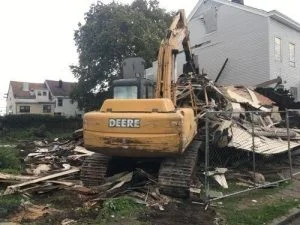Many of us unknowingly come into contact with chemicals every day. They may be present in the air we breathe, the cleaning products we use, or the water we drink. Not all chemicals are necessarily harmful—however, hazardous substances at a cleanup site can be.

In an industrial or commercial space, there may be toxic substances that require careful removal techniques. Various chemicals inside a facility, in the soil, or the water pose risks to demolition contractors and employees. Toxic materials may contaminate our homes, places of occupation, or communities, which could result in various health conditions.
Some of the hazardous substances that may be present at a cleanup site include pesticides, chemicals, metals, petroleum, and pollutants. If these materials are not disposed of properly, it puts the health of workers and nearby residents at risk. When cleaning a hazardous site, it’s important to keep the following considerations in mind:
Potential Health Hazards
Exposure to chemicals, sewage gasses, and other pollutants puts people at risk of the following health issues:
- Cognitive defects
- Higher rates of leukemia, asthma, and cancer
- Organ damage
- For pregnant women: contaminated breast milk or children with birth defects
By scheduling a site cleanup, you can prevent your employees or others in the area from being exposed to harmful chemicals.
The Risks of Improper Hazardous Site Cleanups
Throughout history, several hazardous sites have had disastrous consequences for nearby residents. For example, consider the tragedy that happened at Love Canal.
In the 1950s, a community was built on top of a former chemical waste dump site in New York. Beneath the ground were drums filled with industrial chemical waste. As the toxins leached through the soil, residents suffered from burn marks, birth defects, and high white blood cell counts. The community was eventually demolished and efforts have been made to detoxify the Canal.
As a result of disasters like these, society has come to recognize the importance of proper cleanup methods when disposing of hazardous waste.
Heavily contaminated areas are often managed by the Superfund, an organization that specializes in investigating and cleaning hazardous sites. Under the Comprehensive Environmental Response, Compensation, and Liability Act, sites that threaten public health are managed and remediated accordingly.
By cleaning hazardous sites, we can prevent history from repeating itself and causing harm to the environment and people in those communities.
Protocols for Cleaning Hazardous Sites

Before any cleaning or demolition can begin, the contractors must perform a thorough inspection of the site. This allows them to identify which toxic substances are present, where they’re located, and the safest ways to deal with them.
Using this information, contractors can make recommendations about the most efficient ways to remove the hazards. They can also determine what kinds of protective equipment are necessary for handling the materials. Finally, the contractors must decide where the waste should be disposed of once it’s removed from the site.
To minimize any impact on workers or residents in the surrounding area, contractors must implement cautious, thorough, and research-based site cleaning methods.
At Bella Contracting, our 20 years of experience is invaluable when it comes to cleaning hazardous sites. If you’re planning demolition in New Jersey, contact us today to receive a quote.



